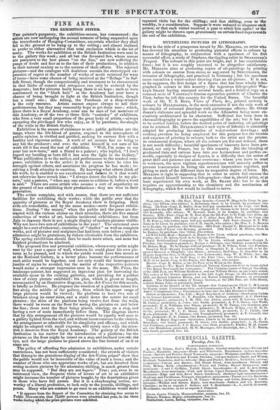MULTIPLYING PICTURES BY LITHOGRAPHY.
Seca is the title of a prospectus issued by Mr. MET I um, an artist who has devoted his attention to producing pictorial effects in colours by means of lithography, in conjunction with a specimen of his first successful effort, a study of Stephan, the tippling sailor in SEAEsPERE'S Tempest. The colours in this print are bright, and it has considerable force ; but it is too roughly executed to be altogether satisfactory. Mr. MELLING aims at producing copies of oil-paintings by printing with colours on canvas from stone, as suggested by SENEPELDER, the inventor of lithography, and practised in Germany ; but his specimen more resembles a water-colour drawing than an oil-picture. It is not, as he supposes, the first design of a figure that has been wholly litho- graphed in colours in this country : the ingenious lithographer Wire Lux SHARP having executed several heads, and a finished copy on a reduced scale of VANDYKE'S famous equestrian portrait of Charles the First, before he left this country for the United States. The beautiful work of Mr. T. S. BOYS, Views of Paris, &c., printed entirely in colours by HULLMANDEL, is the most extensive if not the only work of fax-similes of coloured drawings with picturesque effects ; Mr. Ow= JONES'S elaborate and splendid work on the Alhambra being more ex- clusively architectural m its character. Sufficient has been done in chromolithography to prove the capabilities of the art ; but it has yet to be carried further, before the desired point of imitating oil-paintings can be attained. Mr. HIILLMANDEL'S new style of lithotint is admirably adapted for producing fac-similes of water-colour drawings ; and nothing prevents its being employed for this purpose but the trouble and expense of printing in colours, both to the artist and the printer. In ornamental designs, where all the colours are flat and defined, there is not much difficulty ; beautiful specimens of blazonry have been pro- duced, not only in France, but in this country. But the blending of graduated tints and various hues into one harmonious and perfect en- semble, especially in designs of figures, is a difficulty that the union of great skill and patience can alone overcome : where you have to trust to workmen, the most vigilant superintendence will scarcely suffice to prevent inaccuracies in fitting the several impressions together, and giving to each of the different tints its respective degree of force. Mr. MELLING is right in supposing that in order to attain full success the artist should himself become a lithographer—that is, should print, or at least superintend his own work, as Mr. SHARP did: but to do this requires an apprenticeship to the chemistry and the mechanism of lithography, which few would be inclined to serve.


























 Previous page
Previous page